
RUSTY GRAKLE.
the Redwing, but is composed of much the same materials. In Labrador
I found it lined with moss instead of coarse grass. The eggs are four
or five, of a light blue colour, streaked and dashed with straggling lines
of brown and deep black, much smaller than those of the Redwing, but
in other respects bearing a considerable resemblance to them. They begin
to lay about the 1st of June, in the State of Maine, and fully a fortnight
later in Labrador. They raise only one brood in the season. The
young, when first able to fly, are nearly of an uniform brown, brighter on
the breast and shoulders. Although they seem to prefer alder and willow
bushes, for the purpose of incubation, I have found their nests among the
tall reeds of the Cafs-ta.il or Typha, to which they were attached by interweaving
the leaves of the plant with the grasses and stripes of bark
of which they were externally composed.
During early autumn, and before they remove southward, they frequently
resort to the sandy beaches of lakes, rivers, and the sea, in search
of small testaceous mollusca and aquatic insects. They do little or no
mischief in the corn-fields. While walking they frequently jerk thentail,
and move with much grace, in the same manner as other birds of the
genus. Their flight resembles that of the Red-winged species.
An acquaintance of mine, residing in New Orleans, found one of these
birds, a beautiful male in full plumage, not far from that city, while on
one of his accustomed walks. It had been shot, but was only slightly
injured in one of its wings, and as it was full of vivacity, and had a clear
and brilliant eye, indicating that its health had not suffered, he took it
home and put it in a cage with several Painted Buntings. They soon
became accustomed to each other, the Grakle evincing no desire to molest
its smaller companions. I saw it when it had already been caged upwards
of four months, and had the satisfaction to hear it sing repeatedly.
Its notes, however, were less sonorous than they usually are when the
birds are at liberty. It frequently uttered its travelling chuck-note. It
was fed entirely on rice. This was the only specimen I ever saw in captivity,
and it proved a very amiable companion.
I have figured four of these birds, to enable you the better to understand
their different states of plumage, and placed them on a plant of the
genus Prunus, which grows in Louisiana, and on the berries of which they
occasionally feed.
ORIOLUS FERRUGINEUS, Lath. Ind. Omith. vol. i. p. 120.
QUISCALUS FERRUGINEUS, Ch. Bonaparte, Synops. of Birds of the United States, p. 55.
SCOLECOPHAGUSFERRUGINEUS, RUSTY MAGGOT-EATER, Swains.and RicJiards. Fauna
Bor. Amer. part ii. p. 280.
RUSTY GRAKLE, GRACULA FERRUGINEA, Wils. Amer. Omith. vol. iii. p. 4 1 . pi. 2 1 .
fig. 3. Male.
RUSTY BLACKHIRD, QUISCALUS FERRUGINEUS, Nuttall, Manual, p. 199.
Adult Male. Plate CXLVII. Fig. 1.
Bill of moderate length, straight, tapering, compressed from the base;
upper mandible prolonged on the forehead, forming an acute angle there,
a little decimate at the tip, the dorsal outline slightly convex, the sides
convex, the edges sharp and inflected ; lower mandible nearly straight in
its dorsal outline, convex on the sides, the edges sharp and inflected ;
gap-line deflected at the base. Nostrils basal, oval, half closed above by
a membrane. Head of ordinary size, neck rather short, body rather slender.
Feet of moderate length, strong; tarsus compressed, with a few
long scutella anteriorly, sharp behind ; toes compressed, the lateral nearly
equal, the outer united as far as the second joint to the middle, which is
much longer, hind-toe not much stouter than the inner; claws rather
long, arched, compressed, very acute.
Plumage soft, blended, glossy. Wings rather long, second quill
longest, first and fourth equal. Tail rather long, slightly rounded, of
twelve broad feathers.
Bill and feet black. Iris pale yellow. The general colour is deep
black, with greenish and bluish reflections.
Length 9 | inches, extent of wings 14£; bill along the back f, along
the edge \ \ ; tarsus \ \ .
Adult Female. Plate CLVII. Fig. 2.
Bill, iris, and feet as in the male. The general colour is brownishblack
; the sides of the head over the eyes, and a broad band beneath it
fight yellowish-brown, the feathers of the lower parts more or les margined
with brownish.
Length 8 ^ inches, extent of wings 13£.